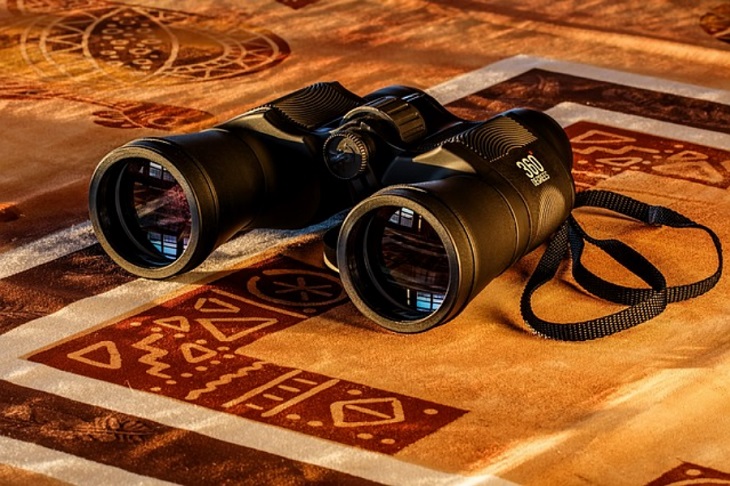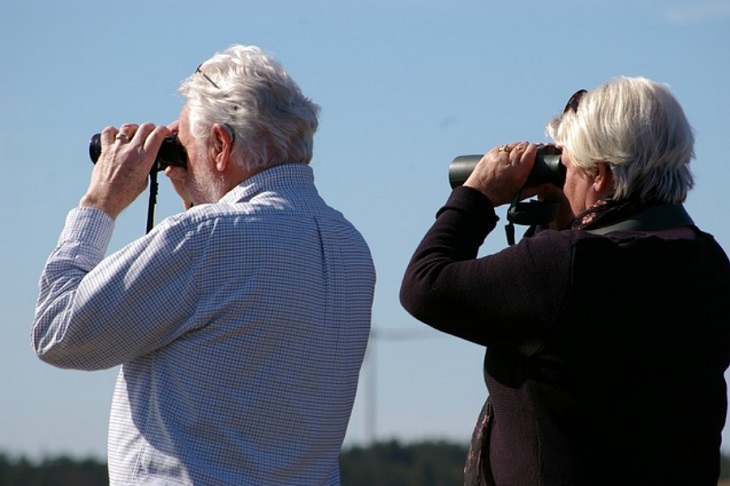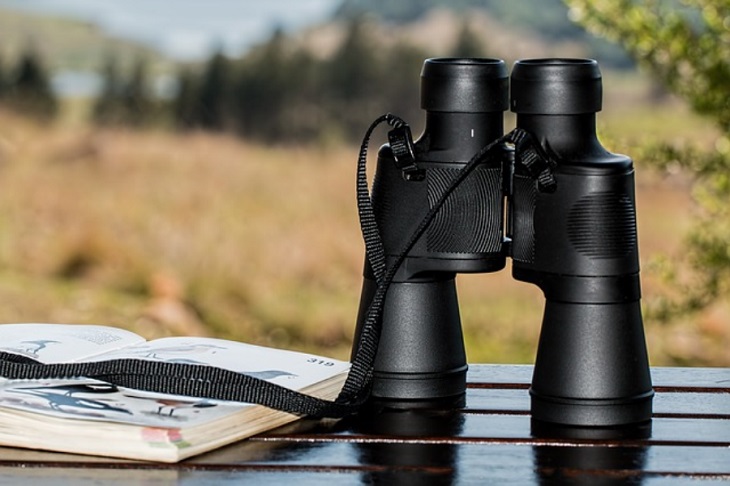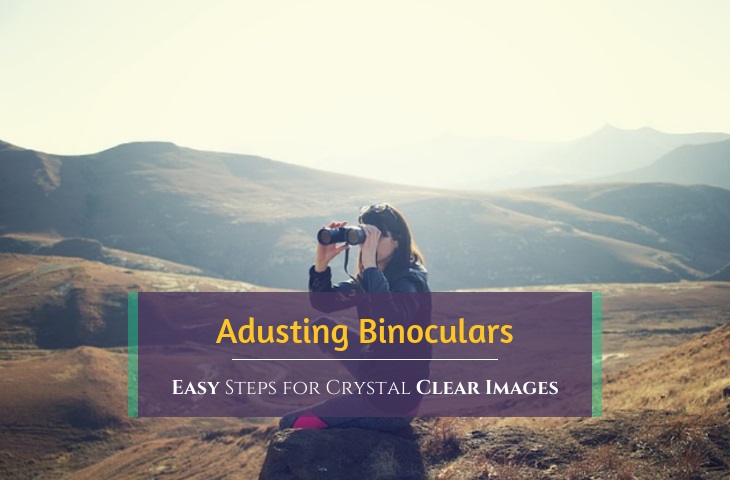Adjusting binoculars for crystal clear images just takes a little bit of know-how. Learn the steps to getting the perfect view every time! While this post talks a lot about using binoculars for bird watching, the information applies to using your binoculars for whatever your favorite sport or hobby is!
Birding is an interesting hobby, but getting a vivid view makes it even more exciting.
The same is true if you're doing a grid search while hunting, trying to get a close up of the action at your favorite sporting event, taking in the sights while traveling, or just enjoy nature watching.

“Look deep into nature and you will understand everything better.”
- Albert Einstein -
While a great set of binoculars will prove useful, adjusting them to be able to get the perfect view is not always an easy, or obvious task. Considering how costly the best binoculars can be, it’s weird that most manufacturers don’t include a detailed operating manual in the package.
Fortunately, when you understand a few simple things, you will be able to improve your experience and achieve sharp images.
Adjusting binoculars is kind of like riding a bike, fun and easy once you get the hang of it.
Quick Links - Adjusting Binoculars FAQS
In this article we hope to answer the most frequently asked questions about adjusting, using and cleaning binoculars. Want to go directly to a question? Click the link.
Understanding The Basics of Binoculars

Understanding binoculars basics will ensure you never miss what you want to see because it's blurry.
The best binoculars for hobbyists come with a few basic features — they incorporate a diopter focus adjustment and a central focus wheel.
The diopter is mostly attached to the right-hand eyepiece of a binocular. Its purpose is to compensate for the visual difference between your two eyes. Typically, no two eyes have the same visual ability. When looking through binoculars, you need to adjust both the central focus and the diopter focus to get clear cut images.
Still on the basics, always use your binocular’s neck strap.
Walking around with your binoculars in your hands can bring lots of trouble. The neck strap is designed to keep them safe around the neck and abutting your chest. That way, you can easily reach it, and it reduces the chances of accidentally dropping it.
Keep the neck strap as short as possible while still allowing you to swing around your binocular comfortably. Longer straps will cause your binoculars to bounce and knock against trees, rocks, or other objects. Some models come with a binocular harness that straps over the shoulder and across your back to distribute the weight of the binocular.
If you're shopping for an affordable pair of binoculars, read our review for the best binoculars under $100.
Adjusting Your Binoculars
Video: Adjusting Diopter on Binoculars - Why it's important and how to make adjustments
Tutorial: Binocular Diopter Adjustment | Courtesy of Vortex Optics
While there are some cheap binoculars that come without diopter focus and central focus, they aren’t suited for getting sharp, clear images and you should keep off such models.
But that doesn’t mean you have to go for the most expensive ones either. You can find a good pair of binoculars under $100 and take your experience to a whole new level.
Now, let’s look at some useful tips on how to adjust binoculars and see crystal clear images.
Adjust the Barrels
If you are getting hold of your binoculars for the first time, you need to pay close attention to the barrels. The space between the two barrels should be adjusted to a point where the barrels line up with your eyes. This is critical since it helps you sight a single clear image when you look through your binocular lenses.
For compact binoculars, this step may not be necessary. So, you should choose a size that fits perfectly in your eyes.
Adjust the Eye Cups
The next step is to check your eye cups and adjust them accordingly. The level of adjustment will differ depending on whether you wear glasses or not.
Birdwatchers or hobbyists who wear glasses should keep the eye cups low. Since eyeglasses block binoculars away from your eyes and filter in peripheral light, it’s a good idea to retract the eye cups for a clearer, comfortable view.
However, if you prefer looking through your binocular with bare eyes, you should roll up your eye cups for better visibility. It also leaves you with easier control and fewer distractions as you view your target.
Set the Diopter
Now that you’re ready to begin the real adventure, the next, and perhaps most important, step is to adjust the diopter.
Why? Because it is very rare for a person to have the same power in both eyes and the diopter accommodates for that. If you wear glasses, this may sound familiar because you are probably used to having two different lens powers.
The diopter is one of the parts that can cause trouble when ignored. A dipole is a critical component of a binocular as it helps to compensate for the difference in the visual ability of your two eyes. If it’s not set properly, there is a high probability that you won’t get a crystal-clear view that every one yearns for.
So, how do you adjust binocular diopters?
Steps for Adjusting Binocular Diopter
Step 1
Look out for the diopter adjustment knob. In most binocular models, the knob is attached around the right eye cup. It sits somewhere between the eye cup and the binocular body.
Most diopter adjustment knobs have a grooved ring to improve the grip and make it easy to loosen or tighten as look for the correct clarity.
Step 2
Once you’ve located the diopter adjustment knob, start by setting up the diopter at the middle. Simply align the main calibration mark with the imprint between the (-) and (+) marks. In most cases, the imprint is marked (0). This is the standard setting for normal eyes. Now, you can look through the binoculars and focus on an object.
Alternatively, you can set up the diopter with each eye separately. Start by manually covering the right eye at the top of the lens and adjusting the focus lens until the left eye sees a crystal clear object. Switch over and block the left eye and focus on the same object through your right eye.
If the image is still as sharp as before, you can sit back and enjoy the view. But, if it is not as sharp, you can adjust your right eye view using the diopter adjustment knob to get a perfect view.
Once the diopter is properly set, you don’t need to touch it again. However, take note of your diopter wheel alignment just in case it moves out of position.
Spot the Object
The secret to successful bird watching is to first spot the bird with your bare eyes. Or if you are a hunter, look directly at your prey. The same thing goes for other hobbyists and sports enthusiasts – always start by spotting what you want to see without the binoculars first.
Once you spot the object, keep looking at it as you slowly move the binoculars to your eyes. Now, turn the central focus wheel on your binocular until you get a sharp image.
It’s always fun to take a moment to look around and gaze at the surrounding environment too.
Since you don’t want to lose track of your target, take note of some vivid features or landmarks near the bird’s location (or whatever it is you are looking at). It could be a brightly colored leaf, a notch in a tree, or even a huge cloud. That will give you a reference point to begin from when your binocular swings out of place.
Fine Tune the Binoculars
The final step is to fine-tune your binoculars to get a perfect image. But how can you tell if the focus is correct?
First, as you look through your binocular lenses, the object should appear almost three dimensional. The bird should vividly pop out and be crystal clear.
Additionally, your eyes should not struggle or strain when using your binoculars. If you notice a mild strain in your eyes or if your glasses give you a headache, there could be a problem with the binocular. Most likely, your binocular is out of alignment. Another common problem with binoculars is double vision.
If you bought your optic from a reputable dealer that offers a warranty, they’ll be willing to service their binocular or offer a replacement.
How to Adjust Binoculars with Double Vision


“Binoculars, and a hawk-like vigilance, reduce the disadvantage of myopic human vision.”
- J. A. Baker -
Many first-time bird watchers often ask, why am I seeing double through my binoculars?
Sometimes, your binoculars can fall out of collimation (the technical term for how the prisms in the barrels are aligned) if you accidentally dropped it or if the package was mishandled during the shipment process. This is a problem that should be fixed by the manufacturer or dealer as long as the binocular is still under warranty.
However, if you’ve been using your binocular for quite some time and its way past warranty, it’s helpful to get some tips on how to fix double vision.
Inside your binocular, two columns of light come in together to make an image. More often, double vision occurs when the objective lens sits askew or when one of the prisms falls out of adjustment. You can correct that by adjusting the prisms back to position.
However, if you can’t do it right, it’s advisable to take it to an expert.
Cleaning Your Binoculars

Getting crystal clear images out of your binocular takes more than just adjusting the focus knob. Sometimes, you’ll see blurred images due to the dirt or grease covering your lenses. Every pair of binoculars needs regular cleaning to deliver perfect images and to increase its lifespan. Cleaning your binoculars wrongly can easily cause damages.
Wiping off the dirt from the binocular lenses with your shirt’s sleeves or a tissue could sound like the easiest option. However, this might cause a lot of tiny scratches on the lens or glass coatings. Over time, the scratches will diminish the clarity of the images your binocular produces.
Video: Tools and technique for cleaning binoculars and spotting scopes
Tutorial: How To Clean Your Binocular | Courtesy of Eagle Optics
NOTE: This video recommends "fogging" lenses with breath. There are mixed thoughts about this due to the enzymes in saliva. It's fine once in a while if you don't have anything else in the field, but best practice is to use a cleaner recommended for lenses.
Getting crystal clear images out of your binocular takes more than just adjusting the focus knob.
Sometimes, you’ll see blurred images due to the dirt or grease covering your lenses. Every pair of binoculars needs regular cleaning to deliver perfect images and to increase its lifespan. Cleaning your binoculars wrongly can easily cause damages.
Wiping off the dirt from the binocular lenses with your shirt’s sleeves or a tissue could sound like the easiest option. However, this might cause a lot of tiny scratches on the lens or glass coatings. Over time, the scratches will diminish the clarity of the images your binocular produces.
The best way to clean your precious binocular lenses is:
Believe it or not, cleaning the lenses of your binoculars is actually not good for them and increases the chances of scratching. Always use clean microfiber cloths and only wipe the lenses when they really need it.
A Few Final Words...


“I think the most important quality in a birdwatcher is a willingness to stand quietly and see what comes. Our everyday lives obscure a truth about existence - that at the heart of everything there lies a stillness and a light.”
- Lynn Thomson, Birding with Yeats: A Mother's Memoir -
With your binoculars set and cleaned, it’s time to explore the outdoors and view your favorite indigenous birds, spot your prey or get a closer look at your favorite sporting event.
But if you haven't tried it yet, birding is quite a refreshing hobby that leaves a lifetime of memories.
One more tip though — always try to keep count of the different bird species you’ve watched and keep track in a birding journal!
